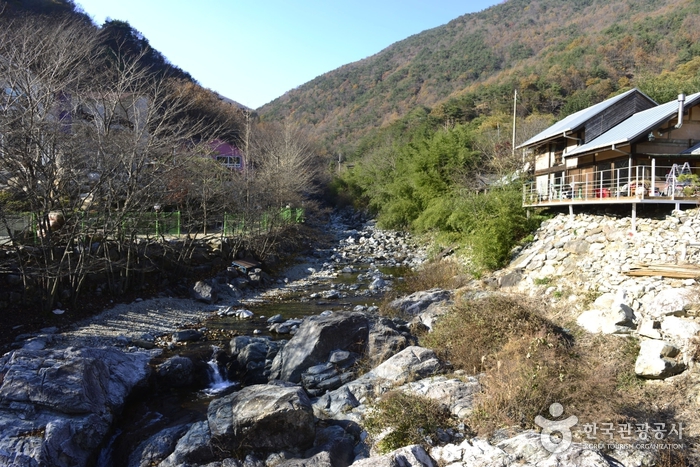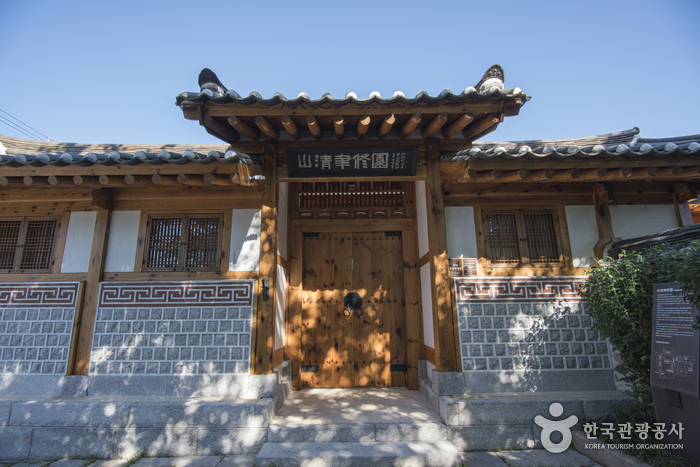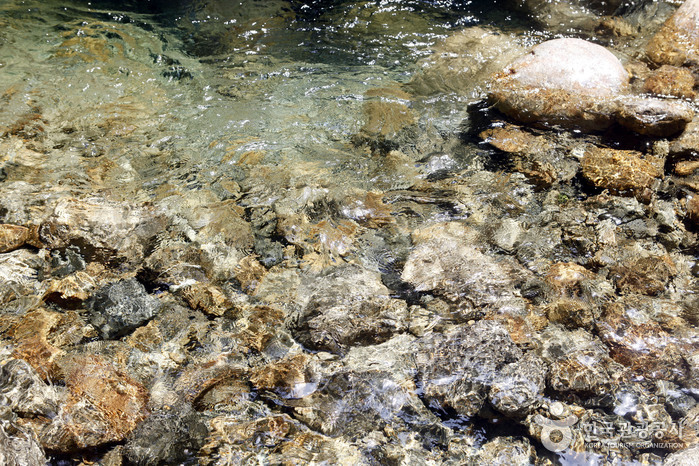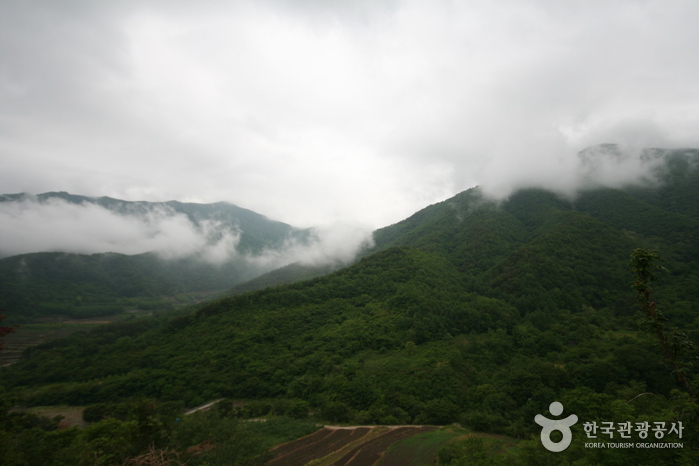Baegundonggyegok Valley, Sancheong (백운동계곡(산청))
11.5Km 2019-12-19
Baegun-ro 51beon-gil, Danseong-myeon, Sancheong-gun, Gyeongsangnam-do
+82-55-970-6421~3
If you go 5 km up along the valley at Baegam-ri, under the thick woods, you will find a 180 square meter long stone named ‘Jeomjeong Rock’ and a small waterfall. This valley is Baegundonggyegok Valley. For almost 6 km, the water of the valley flows over only rocks, with over twenty large and small falls and lakes. Large stones in the valley are gorgeous because the stones are washed with sunbeams and the strong current of water. The most famous falls are Baeunpokpo Waterfall and Odampokpo Waterfall. Strong current of water flows in Deungcheondae, where the letters ‘Yeongnamjeilcheonsok’ are carved. Baegundonggyegok Valley is a clean area due to maintenance of the clean natural environment. Many tourists visit here because the valley is decorated with azaleas in the spring and it is cool in the summer.
Sancheongyulsuwon (산청율수원)
12.6Km 2024-12-19
36 , Sindeunggahoe-ro, Sancheong-gun, Gyeongsangnam-do
+82-55-974-0221, +82-10-9802-1132
Sancheong Yulsuwon is a hanok stay in Sancheong, Gyeongsangnam-do, which has been remodelled from the old Goheon yangban house - with the aim not just of providing accomodation but also of promoting hanok culture. The different buildings are arranged according to feng shui, with Yeongsumun (the gate house), the inner and outer Sarangchae, the dining room and the bathhouse, all arranged protectively around the Anchae or women’s house. Bathrooms and kitchens are installed in all rooms, and the Hagyejae(anchae) has a numaru or upper floor - from where the view is beautiful. There is a red clay Korean sauna in Seoljodang(bathhouse). Nearby tourist attractions include Daewonsa Valley, Namsayedamchon, and Jeongchwiam.
Sancheong Hwangmaesan Mountain (황매산(산청))
13.3Km 2021-04-13
Hwangmaesan-ro 1202beon-gil, Sancheong-gun, Gyeongsangnam-do
+82-55-970-6901
One of the last mountains of the Taebaek Mountain Range, Hwangmaesan Mountain is located in Sancheong, Gyeongsangnam-do. The mountain features fantastic rock formations and a beautiful vista from the summit that resembles arpricot blossoms. It is said that anyone who prays from the summit will have their wish come true, drawing in plenty of earnest hikers. In May, a large field near the summit is covered in vibrant pink royal azaleas. Attractions on the mountain include Bakjwigol Valley, Norubawi, Heundeulbawi, Janggunbawi, Chotdaebawi, Geobukbawi and Sinseonbawi Rocks among others.
Hwangmaesan County Park (황매산군립공원)
13.5Km 2025-01-13
4, Hwangmaesangongwon-gil, Hapcheon-gun, Gyeongsangnam-do
+82-55-930-4752
Located at the border between Gahoe-myeon and Daebyeong-myeon of Hapcheon, Hwangmaesan Mountain has long been considered a guardian mountain of Hapcheon, but was rarely ever featured in hiking or tourist publications. Thanks to this, the mountain's natural environment has been kept in pristine condition. In 1983, the mountain was designated as a county park and now, along with Gayasan Mountain, it is regarded as one of the major mountains in Hapcheon. Hwangmaesan Mountain is one of the last mountain peaks of the Taebaek Mountain Range, and reaches an altitude of 1,113 meters. Pine trees and royal azalea decorate the rocky mountain. From the summit, hikers can see Hapcheonho Lake and Jirisan, Deogyusan, and Gayasan Mountains.
Jirisan Chilseongyegok Valley (칠선계곡(지리산))
13.9Km 2022-07-29
Chuseong-ri, Hamnyang-gun, Gyeongsangnam-do
+82-55-970-1000
Chilseongyegok Valley is the most beautiful valley in Jirisan Mountain, and is one of the top three valleys in the nation, along with Cheonbuldonggyegok Valley in Seoraksan Mountain and Tamnagyegok Valley in Hallasan Mountain. The 16-kilometer valley stretching from Uitan of Macheon-myeon to Cheonwangbong Peak is characterized by very tough topography but beautiful scenery and is the only remaining primeval forest of Jirisan Mountain. It is also dotted with seven waterfalls and 33 ponds. The hike becomes more difficult as the trail enters the valley. Because the valley has taken many lives, some people call it "The Valley of Death." For that reason, visitors must apply in advance and hike with a guide. The trail in Chilseon Valley is a 9.4-kilometer course from Chuseong Village in Macheon-myeon to Cheonwangbong Peak, which does not follow the natural valley, due to the valley's steep and dangerous features. Starting from Chuseong Village, the trail passes Yongso Pond, Jujiteo Site, Chuseongmang Rock, Seonnyeotang Pond, Ongnyeotang Pond, Biseondam, Chilseonpokpo Falls, Daeryukpokpo Falls, Samcheungpokpo Falls and Mapokpo Falls, all before reaching Cheonwangbong Peak.
Jirisan National Park (Sancheong) (지리산국립공원(산청))
15.0Km 2025-03-28
320-2 Jirisan-daero, Sicheon-myeon, Sancheong-gun, Gyeongsangnam-do
+82-55-970-1000
* Please be advised that this is located in one of the areas affected by the recent wildfire (as of March 27, 2025).
** For real-time wildfire information and emergency upates, visit the Korea Forestfire Information website and the National Disaster and Safety Portal.
Jirisan National Park is the first national park established in South Korea, featuring peaks like Cheonwangbong Peak (1,915m), Banyabong Peak, and Nogodan Peak, which rank as the next highest after Halla Mountain. It's a popular destination for mountain enthusiasts, offering beautiful natural landscapes such as Naewonsagyegok Valley. The park also provides convenient facilities like Jirisan Recreational Forest, Naewonsa Temple, mountain lodges, campgrounds, and pensions.
Yedamwon (예담원)
15.0Km 2024-02-23
10-4 Jirisan-daero 2897beon-gil, Danseong-myeon, Sancheong-gun, Gyeongsangnam-do
Yedamwon is a traditional Korean restaurant situated in Namsa Yedamchon Village, near the entrance of Jirisan Mountain. The highlight of the menu, Maehwa jeongsik (maehwa set menu), features a delightful array of local dishes, including suyuk (boiled pork slices), saengseon gui (grilled fish), and dotorimuk muchim (acorn jelly salad). Renowned for its commitment to organically grown ingredients and the use of natural seasonings, such as green plum extract and gamsikcho (persimmon vinegar), the restaurant attracts numerous visitors seeking an authentic culinary experience.
Namsa Yedamchon Village (남사예담촌)
15.1Km 2024-10-23
10 Jirisan-daero 2897beon-gil, Danseong-myeon, Sancheong-gun, Gyeongsangnam-do
Namsa Yedamchon Village is situated at the foot of Jirisan Mountain. It is a traditional hanok village renowned for its history as the birthplace of accomplished scholars, adding to the region's rich scholarly tradition. This meticulously preserved village boasts ancient hanok houses, venerable trees, and historic walls. Beyond its significance as a center for traditional culture, the picturesque village also offers experiential programs, including the opportunity to wear hanbok and engage in traditional games.
Jirisan Cheonwangbong Peak (지리산 천왕봉)
15.1Km 2025-03-28
Jirisan-daero, Sancheong-gun, Gyeongsangnam-do
+82-55-970-1000
* Please be advised that this is located in one of the areas affected by the recent wildfire (as of March 27, 2025).
** For real-time wildfire information and emergency upates, visit the Korea Forestfire Information website and the National Disaster and Safety Portal.
Along with Geumgangsan Mountain and Hallasan Mountain, Jirisan Mountain is known to be one of the most sacred mountains in Korea. It was named "Jiri" because it was believed to be a place that turns the innocent into the wise. On December 29, 1967 Jirisan National Park was declared the nation’s first and biggest national park. Its 440.517 square kilometer area covers Hadong, Sancheon and Hamyang in Gyeongsangnam-do; Gurye in Jeollanam-do ; and Namwon in Jeollabuk-do region. The total area is seven times that of Gyeryongsan National Park and 52 times that of all of Yeouido Island in Seoul.
At 1,915.4 meters high, Cheonwangbong Peak is the second highest peak in Jirisan National Park. Countless valleys and waterfalls surround the peak, as well as trails connecting to other peaks within the park.
Seoamjeongsa Temple (서암정사(함양))
15.4Km 2024-02-21
27-79 Gwangjeom-gil, Macheon-myeon, Hamyang-gun, Gyeongsangnam-do
Seoamjeongsa Temple belongs to Byeoksongsa Temple, which is at the entrance of the Chilseongyegok Valley of Jirisan Mountain. Monk Woneung rebuilt Byeoksongsa Temple, which had been damaged during the Korean War in 1950. This hermitage features the Buddha statues Woneung carved into the natural bedrock, a grotto sanctuary with statues of the Pure Land, Daebanggwangmun Gate, and Sajagul Cave.






 English
English
 한국어
한국어 日本語
日本語 中文(简体)
中文(简体) Deutsch
Deutsch Français
Français Español
Español Русский
Русский